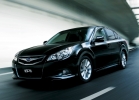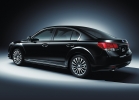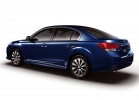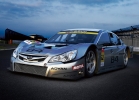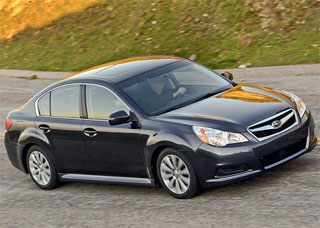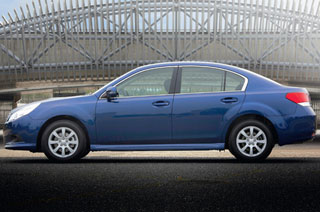Subaru Legacy West drive sedan since 2009 sedan
Legacy and Outback from $ 18,000

You can hear many stories about Subaru cars, sometimes completely incredible. In fact, these all -wheel drive machines with opposition engines are a typical product of the Japanese auto industry - quite simple and effective technical solutions, worked out in decades, make them reliable and durable.
The second generation of Outback, like the previous one, appeared in 1999, was based on the Legacy platform. In principle, it was Legacy station wagon, only with an enlarged clearance and changed bumpers. Therefore, we will talk at the same time about Legacy and Outback.
Engines
The choice of engines was small, which is typical for Japanese cars. Opposite fours with a volume of 2 and 2.5 liters were installed on cars and the opposite six (3 l). 2-liter engines in Russia are slightly due to the fact that the power of this engine is still not enough for a sufficiently large all-wheel drive car. There were also options with 2-liter turbo engines, but they were not supplied to us, and for our country it is pure exotic. 2.5 liters (156 hp) engines for the new generation of cars were modernized, problems with overheating of the motor have disappeared, in the heads of the block now, instead of two camshafts, only one, but the valves are still 16. Three-liter sixes with a capacity of 209 liters. With. They have a timing chain drive, the rest of the maintenance procedure and the features of these engines are common. The advantages of opponent are compactness and low center of gravity. Since the engine is located below, all attachments are carried upstairs under the hood cover, which allows you to better protect it from dirt and facilitate access to it. But due to the fact that the cylinders are located horizontally, the block heads almost rest against the spar and work under valve lids can only raise the motor. This is not very convenient, but, on the other hand, there is practically no need to climb there. Despite the fact that there are no hydraulic compensators of the gaps of the valves, the check and, if necessary, adjust the heat gaps is provided once every 160 thousand km (!).
This alone indicates the quality and durability of the engines. Replacing the timing belt ($ 215) is provided every 100 thousand km, but at least once every two years. Oil (not lower than SJ) and filters require replacement every 10 thousand km. As for the maintainability of the engines, the overhaul of these engines is basically possible, two repair sizes of the piston group are provided. But, according to service experts, it is much easier to buy a backing engine and install in return for a failed. True, bringing the matter to overhaul, specially without killing the motor, is not so simple. There are legends that Subaru engines withstand a mileage up to 1 million km. It is difficult to say whether this is so, but half a million is practically guaranteed with timely maintenance. On a 2.5 liter of release of 1999, there were problems with the launch of strong (-25s) frosts. This was due to the disadvantages of the engine control unit. The problem was solved by changing the control program. On cars 2001-2002 Also, on the engines of 2.5 liters in the heat, unstable work was observed at the time of disconnecting the air conditioner compressor, sometimes the motor could even stall. The reason was again software. Such machines were revoked for reprogramming the control unit, after which the problems disappeared. On 3-liter engines in 2001-2002. There were problems with the launch of the engine at temperatures below -15C, control units were also reprogrammed to eliminate the defect. In principle, all these shortcomings were caused by the transition to more stringent norms of the exhaust toxicity, but the refinement was made centrally by the manufacturer, so it is unlikely to find a car with such misunderstandings today. But if this still comes across, contact the dealer, and the problem will probably be eliminated.
Transmission
Full -wheel drive is a subaru trump card. Today, you will not surprise anyone with an all-wheel drive machine, but Subaru’s all-wheel drive transmission settings are still almost the best, and it is easy to control any of Subaru on any coating in any weather. In addition, all -wheel drive transmissions are very reliable and do not deliver any trouble to the owners. The checkpoint, together with the viscous and front gearbox, are made in one case, and quite compact, the rear gearbox is also small in size, so the parts of the transmission from the bottom do not stick out, everything is removed into the central tunnel, so it is almost impossible to damage the crankcase and the gearbox. The machines of the generation in question received new 5-band automatic transmission, working more smoothly. Cars with 2.5 -liter engines were equipped with mechanical boxes with a demultiplier. Together with the mechanics, two -hay flywheels with a damper of steep fluctuations were installed, and this is the only thing that can ruin the mood of the owner of a used Legacy or Outback. When the damping elements in such flywheels wear a little, they begin to publish characteristic clicks. With such a sound, the flywheel will work for a very long time, but if the clicks are nervous, you can replace the flywheel and the clutch mechanism with the nodes from the release car until 1999 - there is a single -mass flywheel. Such an operation will cost $ 1400. Transmission service is reduced to a replacement once every 50 thousand km of oil in boxes and gearboxes. The machine requires DEXTron III, in mechanics and gearboxes - GL -5. You also need to monitor the condition of the anthers of the drives, if necessary, change them. Problems with the transmission can arise only if the owner of the car decides that he has an army SUV or artillery tractor, and will use the machine accordingly. Both Legacy and Outback are cars, albeit all -wheel drive, and with an enlarged clearance. If you remember this, then the transmission will live no less than the engine.
Suspension and steering
Unlike the previous generation, a new back suspension was used on the machines in question, made according to a multi -link scheme. This has also improved and so excellent stability and controllability, and reliability and durability were not affected. The front suspension remained almost unchanged. The stabilizer racks have become durable, now they should be changed once every 30-40 thousand km ($ 40 per one). Shock absorbers on Moscow roads withstand 70-80 thousand km. The most expensive versions of cars were equipped with shock absorbers supporting a permanent clearance regardless of the load. Their resource is the same as that of ordinary ones. Replacing shock absorbers costs about $ 500 per pair of front and from 350 for usual to $ 1350 for adjustable for the rear. Silent-blocks and ball supports (which are only two) withstand 150-170 thousand km, replacing them for the owner is not indilative. Sometimes the problems with the bearings of the rear hubs on the machines of the past generation were caused by the design not very suitable for our conditions. On the cars of the generation in question, the design of the hub unit has been changed, and now durability and reliability have increased significantly. The steering rheck with a hydraulic wrap, works reliably, no problems. About once every 70 thousand km, you need to change the steering tips ($ 70), and that’s all.
Brake system
All brakes are disk, with ABS and VDC stabilization system. For greater efficiency, the front brake discs were made softer, so their resource decreased slightly. But still, they withstand about 90 thousand km (three sets of pads). The cost of replacing the pads is 160 dollars for the front and 130 for the rear. Replacing the front brake discs along with the blocks costs about $ 430. You also need to monitor the condition of the brake hoses and change them in a timely manner. Brake fluid replacement is provided once every two years ($ 30).
Body and electrical equipment
For the European market, Legacy was produced with bodies of sedan and station wagon, and Outback only with the wagon body. For the American market, sedans with an enlarged clearance were also produced, which are found with us. There should be no problems with them, since constructively these machines are absolutely identical to European and all spare parts from Europeans are suitable for them. Unless, when registering, questions may arise about American lighting equipment, which differs from the European one. The body does not cause complaints, corrosion resistance is very good. The doors of Subaru are traditionally without a scope for glasses, but the seal of the joint between the glass and the opening is made competently, there are no drafts on this joint. As for the decoration of the salon and equipment, the car according to these parameters can be attributed to strong middle peasants in its class. Everything is done solidly, neatly, from good materials, but no more - in a word, on the principle of reasonable sufficiency. There are few options for the configuration, but the machines are decent: climate control, electric package, heating seats, brushes, leather salons are not uncommon. There are no problems on electrical equipment, everything works reliably, which again is typical for Japanese cars.
findings
Subaru Legacy and Outback seemed to be designed for our weather and road conditions. This is also evidenced by the LEGACY of the early 90s and today are in demand in the market of used foreign cars. As for the latest generation machines, people who value manageability, running qualities and the ability of the car confidently move on any coating, but at the same time believe that the SUVs are somewhat big and heavy for them, Outback and Legacy are just right. In addition, these cars contrary to conventional opinions have, albeit with some features, but a fairly simple design. The complexity, and therefore the cost of their maintenance and repair, is not so high, so when choosing a used car, the main task will be to find a car in good condition. The fact is that some owners use Subaru as a jeep and in a few years of such cruel operation they bring the car to a deplorable state, although outwardly it may look quite decent. If you then engage in the restoration of the machine, undermined by the previous owner of the health of the machine, it may be expensive to do. Therefore, it is better to come to the corporate service before buying, conduct a thorough diagnosis, find out what the car will cost in order, and then make a decision on the purchase. As for the cost of 3-year-old cars, in Moscow they are asked for $ 18 thousand for Legacy to 30 thousand dollars for Outback.
Text: Leonid Klimanovich
A source: Avtopanorama magazine

